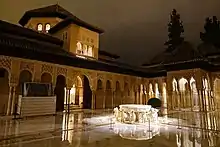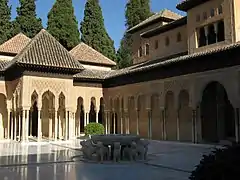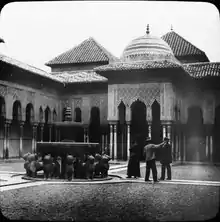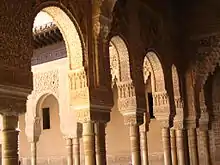Court of the Lions
The Court of the Lions (Spanish: Patio de los Leones; Arabic: بهو السباع) is the main courtyard of the Nasrid dynasty Palace of the Lions, in the heart of the Alhambra, the Moorish citadel formed by a complex of palaces, gardens and forts in Granada, Spain. It was commissioned by the Nasrid sultan Muhammed V of the Emirate of Granada in Al-Andalus. Its construction started in the second period of his reign, between 1362 and 1391 AD. The site is now part of the UNESCO World Heritage List[1] and minted in Spain's 2011 limited edition of 2 € Commemorative Coins.





Background and architectural influences
The Palace of the Lions, as well as the rest of the other new rooms built under Muhammad V,[2] like the Mexuar or Cuarto Dorado, represented the beginning of a new style, an exuberant mixture of Moorish and Christian influences that has been called Nasrid style. During the period that Muhammad V was ousted as sultan of Granada by his stepbrother, Abu-l Walid Ismail, he discovered in exile a host of new aesthetic influences that were not in the language of his predecessors, not even in his own first contributions to the enrichment of the Nasrid palaces of the Alhambra. In Fes he saw the Almoravid mosque of Qarawiyyin, built by Moroccan architects. The splendor of the decorations, specially the profuse use of the muqarnas that had once decorated the palaces and mosques of Al-Ándalus, stunned the ex-sultan, as did the ruins of the Roman city of Volubilis, where he could directly examine the classical orders, Roman ornamentation and, above all, the disposition of the Roman impluvium; the Roman ruins at Volubilis were particularly well preserved since they had been abandoned for a period of time in the Middle Ages and later re-used as a necropolis.[3]
Muhammad became an ally of his personal friend, the Christian king Pedro I of Castile, who helped him to regain the throne and defeat the usurpers. Meanwhile, he was also astonished with the construction of the palace of Pedro I, the Alcázar of Seville, built in Mudéjar style by architects from Toledo, Seville and Granada. The influence of this Mudéjar style of King Pedro in the future Palace of the Lions was going to be decisive, especially the structure and disposition of the Qubba rooms along two axis of the 'Patio de las Doncellas' ("Courtyard of the Maidens").
Description
The Courtyard of the Lions is an oblong courtyard, 35 m in length and 20 m in width, surrounded by a low gallery supported on 124 white marble columns. A pavilion projects into the courtyard at each extremity, with filigree walls and light domed roof, elaborately ornamented. The square is paved with coloured tiles, and the colonnade with white marble; while the walls are covered 1.5 m up from the ground with blue and yellow tiles, with a border above and below enamelled blue and gold. The columns supporting the roof and gallery are irregularly placed, with a view to artistic effect; and the general form of the piers, arches and pillars is most graceful. They are adorned by varieties of foliage, etc.; above each arch there is a large square of arabesques; and over the pillars is another square of filigree work. In the center of the courtyard is the celebrated Fountain of Lions, a magnificent alabaster basin supported by the figures of twelve lions in white marble. At present, the fountain is under restoration in an effort to preserve its integrity.
It has been argued by Georges Marçais that the spacing of columns and arches was set to the golden ratio, but there is no strong evidence that Muslim architects ever used it. Instead, as Antonio Fernández-Puertas postulates, the rectangles used in the construction may have been based on square roots and surds.[4]
Meaning of the structure
The structure of the courtyard, has, as it has been said, a direct influence of the Sevillian Patio de las Doncellas, but its meaning and origins trace their roots to early Islamic gardening, the courtyard divided in four parts, each one of them symbolizing one of the four parts of the world. Each part is irrigated by a water channel that symbolize the four rivers of Paradise. This courtyard is, therefore, an architectural materialization of Paradise, where the gardens, the water, and the columns form a conceptual and physical unity. The slender column forest have been said to represent the palm trees of an oasis in the desert, deeply related with Paradise in the Nasrid imagination. In the poem of Ibn Zamrak on the basin of the fountain, a further meaning is stated clearly: "The fountain is the Sultan, which smothers with his graces all his subjects and lands, as the water wets the gardens."
Nowadays the flower garden has been replaced by a dry garden of pebbles, in order not to affect the foundation of the palace with the watering. In Nasrid times, the floor of the quartered planting beds was slightly lower than the general level, and the visual effect was like a tapestry of flowers, as the top of the plants were cut to the same level of the courtyard, and these were carefully chosen to cover a host of color nuances.
Lion Fountain
_-_Armandoreques.jpg.webp)
Some research suggests that the 11th century lions of the Lion Fountain came from the house of the Jewish vizier Yusuf ibn Nagrela (d. 1066). It is not known if they were made before his death, and at the time, he was accused of wanting to build a bigger palace than the king's.[5] They are large for sculptures of animals in Islamic art, but as in other sites of al-Andalus such as the earlier Medina Azahara near Cordoba, there are multiple animals. The Pisa Griffin is even larger.
There is an almost exact description of the original fountain, written by the poet Ibn Gabirol in the 11th century. They represent the 12 tribes of Israel, two of them have a triangle on the forehead, indicating the two extant tribes Judá and Leví. The Lions were removed in 2007 for restoration on the premises while the fountain was restored in situ. The lions were put back in place in July 2012 after reconstruction of the traditional water flow system of the Court of the Lions.
Excerpt of Ibn Zamrak's poem on the basin
The poet and minister Ibn Zamrak wrote a poem to describe the beauty of the courtyard. It is carved around the rim of the basin:[6]
وَمَنْحُوتَة مِنْ لُؤْلُؤٍ شَفَّ نُورُهَا تُحَلِّي بِمُرْفَضِّ الجُمَانِ النَّوَاحِيَا |
Such a translucent basin, sculpted pearl! |
See also
References
- Centre, UNESCO World Heritage. "Alhambra, Generalife and Albayzín, Granada". UNESCO World Heritage Centre. Retrieved 2020-07-30.
- John Stothoff Badeau, John Richard Hayes, The Genius of Arab Civilization: Source of Renaissance, 1983, MIT Press, 260 pages ISBN 0-262-58063-2
- Map, The Megalithic Portal and Megalith. "Volubilis". The Megalithic Portal. Retrieved 2018-02-22.
- Irwin, Robert (2011). The Alhambra. Profile Books. p. 111. ISBN 9781847650986.
- official site
- Ed. by José Miguel Puerta Vílchez, Reading the Alhambra: A Visual Guide to the Alhambra Through its Inscriptions, trans. by Jon Trout ([no place]: The Alhambra and Generalife Trust and EDILUX s.l., 2010), p. 169.
Source
- Robert Irwin, The Alhambra, ISBN 978-1-86197-487-7, 2005
- Manzano Martos, Rafael. La Alhambra: El universo mágico de la Granada islámica. Editorial Anaya, 1992. ISBN 84-207-4833-1, ISBN 978-84-207-4833-7
- Chueca Goitia, Fernando: Invariantes castizos de la Arquitectura Española. Manifiesto de la Alhambra ISBN 84-237-0459-9
- García Gómez, Emilio: Poemas árabes en los muros y fuentes de la Alhambra. Instituto Egipcio de Estudios Islámicos. Madrid, 1985. ISSN 1132-3485
- Al-Hassani, S.T.S, (2012). 1001 inventions: The Enduring Legacy of Muslim Civilisation. National Geographic. ISBN 978-1426209345.
External links
| Wikimedia Commons has media related to Patio de los Leones (Court of the Lions). |
| Wikimedia Commons has media related to Palacio de los Leones. |